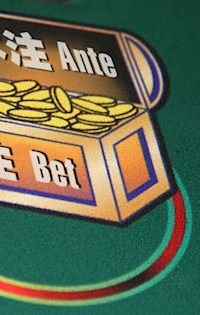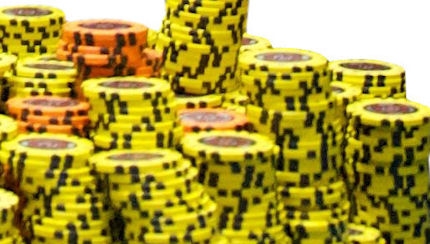This article first appeared in the Jan/Feb 2012 issue of World Gaming magazine.
There are many different versions of poker like omaha, seven-card stud and the game that has taken the world by storm, texas hold’em. Despite it’s title, caribbean stud poker should not be confused with these traditional poker games that pit player against player. Caribbean stud poker is a table game played against the casino, just like baccarat, roulette or craps. However, caribbean stud has some similarities to traditional poker, such as the employment of the poker hand ranking system.

Like many casino table games, the precise origins of caribbean stud remain a mystery. Several people claim to have had input in the game’s invention and development. We know that caribbean stud was born some time in the 1980s and proved a popular pursuit in Aruba and on the cruise ships in the Caribbean, hence its name. The game’s invention was a stroke of genius, as it was the first time casino operators could offer a poker-based game in a player-against casino table game format. It had limited early success, and it was not until a linked progressive jackpot was introduced that the game really flourished. As is often the case, the added incentive of a major jackpot was just the thing to get players interested. Caribbean stud was then marketed and distributed in Nevada and the rest, as they say, is history.
Caribbean stud is easy to play once you master the basics. The major similarities to poker are that it uses a standard 52-card deck of playing cards, and that the traditional poker hand ranking system is used to determine the payout structure. The use of the word ‘stud’ is somewhat confusing, as that term refers to any poker variant where players receive a mixture of face-up and face-down cards. However, caribbean stud does not see its players dealt any cards face up. The game is most similar to ‘draw’ poker, where a player is dealt five down cards. The only difference is that caribbean stud poker has no ‘draw’ (a process where players discard unwanted cards and replace them with fresh cards from the deck). But enough about poker, let’s concentrate on the dynamics of caribbean stud.
To start the game a player must place an initial bet, or ‘ante’. At this point a player may also place an optional jackpot side bet. We will explain the jackpot element of the game in a future article of our series on caribbean stud, but you will find the majority of players do indeed exercise their option to play the jackpot, because of the huge payout possible. Once every player has placed his initial ante bet, the dealer deals each player five cards face down. The dealer also receives five cards, but exposes one of his cards face up on the table for all to see.

After the player looks at his five cards he has two options. The first of these options is to fold. By folding, the player returns his unwanted cards to the dealer and forfeits his ante bet. If the player chooses this option then his participation in the hand is complete, and he can sit back and wait for the next hand to be dealt.
The second option is to continue with the hand. At this stage, the player is required to place an additional wager that must be exactly twice the size of his ante. For example if he has a $100 ante, he must now raise an additional $200 (making the total amount bet on the hand $300). Once each player has made the decision to fold or to raise by double his ante, the dealer turns over his remaining four cards to reveal his five-card hand.
The dealer must have at least AK high to have a playable hand. This is where the poker ranking system comes into play. AK high means any hand that contains both an ace and a king, or any hand of one pair or better. The lowest opening hand for the dealer is therefore AK234. All hands from a pair of 2s up through the normal poker hand rankings all the way to the best possible hand, a ‘royal flush’ (AKQJT, all of the same suit), are playable hands for the dealer.
If the dealer can’t open because he doesn’t have at least AK high, then he automatically pays the players even money on their ante bets. The raise bet is simply returned to the player and is considered a stand off (also known as a ‘push’), meaning it neither wins nor loses.
If the dealer ‘opens’ (that is he has AK high or better) his hand is compared to each individual player’s hand. The players whose hands are higher than the dealer’s hand win, and the players whose hands are lower than the dealer’s hand lose. The losing players lose both their ante and raise bets. Things start to get interesting for the players that win. To start with, their ante is paid at even money. Their raise bets are paid at differing odds depending upon the strength of their hand. The following table shows the payout structure:
|
Poker hand
|
Payout
|
|---|---|
|
AK high or one pair
|
Even money 1 to 1
|
|
Two pair
|
2 to 1
|
|
Three of a kind
|
3 to 1
|
|
Straight
|
4 to 1
|
|
Flush
|
5 to 1
|
|
Full house
|
7 to 1
|
|
Four of a kind
|
20 to 1
|
|
Straight flush
|
50 to 1
|
|
Royal flush
|
This varies in Macau casinos but can be 50 or 100 to 1
|
In the very unlikely scenario the dealer opens and the player and the dealer have the exact same hand (that is they each have five cards of the exact same rank), the entire hand is treated as a stand off (or push), and both the ante and the raise are returned to the player.
As you can see, very large amounts can be won if a player is lucky enough to hit a big hand. Another attractive feature of this game is the progressive jackpot, which allows participants to win huge amounts of money from a very small investment. We will explain the progressive jackpot and give you some tips on how best to play the game in future parts of our series on caribbean stud poker, coming soon in World Gaming.







